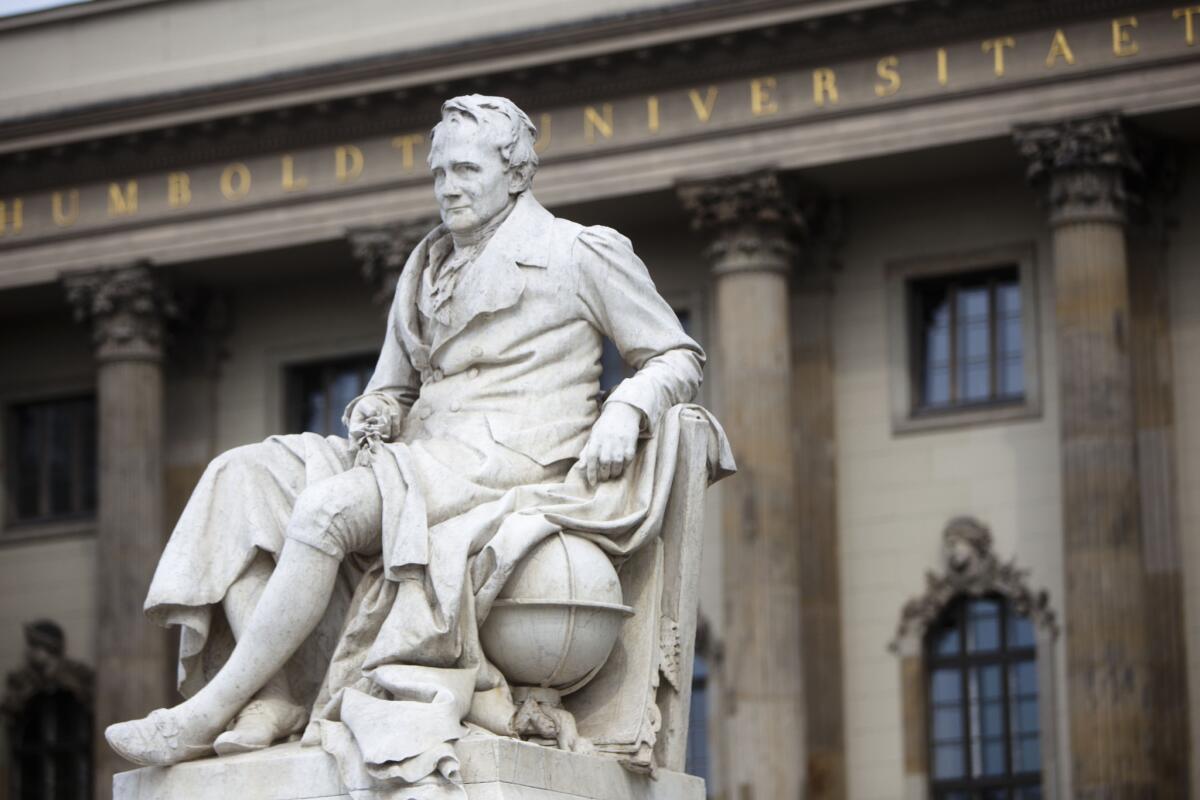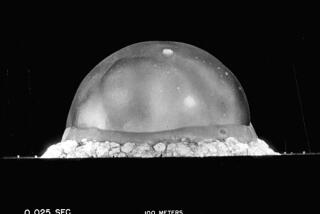Op-Ed: Alexander von Humboldt: The man who made nature modern

The statue of German scientist Alexander von Humboldt in front of the main building of the Alexander von Humbolt University in central Berlin on April 27, 2011.
His contemporaries considered Alexander von Humboldt the most famous man in the world after Napoleon, and Thomas Jefferson called him “one of the greatest ornaments of the age.” There are more plants, animals, minerals and places named after Humboldt than any other person. In California alone, a county, a bay, a college and a state park all bear his name. He is a founding father of environmentalism, a visionary who predicted man-made climate change as early as 1800.
Yet Humboldt is almost forgotten in the English-speaking world. We see his name on maps, on the information cards at the zoo or in the newspaper — the Humboldt Current, the Humboldt penguin, Humboldt State, the Humboldt mountain range — but most Americans know little about the man.
Born in 1769 into an aristocratic Prussian family in Berlin, Humboldt discarded a life of privilege and spent his substantial inheritance on a dangerous five-year exploration of Latin America.
He ventured deep into the mysterious rain forests in Venezuela and paddled along crocodile-infested tropical rivers. He walked thousands of miles through the Andes, from Bogota, Colombia, to Lima, Peru — climbing volcanos along the way, including Chimborazo, then believed to be the highest mountain in the world.
He was fascinated by scientific instruments and empirical data, but equally driven by a sense of wonder. At almost 20,000 feet and nauseated by altitude sickness, Humboldt measured the chemical components of the air and also described nature’s majestic beauty. Where other scientists were searching for universal laws, Humboldt wrote that “nature must be experienced through feeling.”
When he returned to Europe, his trunks were filled with dozens of notebooks, hundreds of sketches and tens of thousands of astronomical, geological and meteorological observations, and some 60,000 plant specimens. Over the next 50 years, Humboldt published so many books that even he lost track.
The most famous was the multivolume, bestselling “Cosmos,” which was translated into a dozen languages. In it Humboldt took his readers on a thrilling journey from outer space to Earth, bringing together distant nebulae, the geography of plants and erupting volcanoes. He wrote about landscape painting, terrestrial magnetism and nature in poetry. “Cosmos” was unlike any other book, and Walt Whitman composed his celebrated poetry collection, “Leaves of Grass,” with a copy on his desk.
When Humboldt died in 1859, aged 89, he was arguably the last great polymath, a man who investigated nature not just with scientific methods but also by looking at art, history, literature and economics. He searched for global patterns, and his most important insight was that nature is a web of life. At a time when scientists were classifying the world into ever smaller taxonomic units, Humboldt regarded Earth as one great living organism in which everything was connected. It was a radically new approach, and it makes him a naturalist hero for the 21st century.
As he traveled through Latin America, Humboldt recognized nature’s vulnerability and the devastating environmental effects of colonial cash crop cultivation: Monoculture and deforestation made the land barren, washed away soil and drained lakes and rivers.
Humboldt was the first to understand the forest as an ecosystem: the forest’s ability to enrich the atmosphere with moisture, its cooling effect as well as its importance for water retention and protection against erosion. Large-scale irrigation, he said, would turn parts of Venezuela into arid deserts and the valleys beneath the high plateau of Mexico into desolate landscapes.
Humboldt wrote that the “wants and restless activity of large communities of men gradually despoil the face of the Earth.” In 1844, he prophetically listed three ways in which the human species was even then affecting the climate: “Through the destructions of forests, through the distribution of water, and through the production of great masses of steam and gas at the industrial centres.”
It is hard to overestimate his effect on what came next. It was Humboldt, for example, who inspired John Muir’s ecological thinking. Almost 70 years younger, Muir grew up reading Humboldt’s books.
“How intensely I desire to be a Humboldt,” Muir declared when he was in his 20s. Muir’s famous quotation — “When we try to pick out anything by itself, we find it hitched to everything else in the universe” — owes a great deal to Humboldt’s ideas that nothing, not even the tiniest organism, could be looked at on its own. “In this great chain of causes and effects,” Humboldt wrote, “no single fact can be considered in isolation.”
Muir left behind heavily annotated copies of Humboldt’s books. Pencil in hand, he scribbled in the margins of his copies, which are now in the special collections of the University of the Pacific in Stockton. On the endpapers Muir devised his own extensive indexes. He highlighted passages about the impact of trees on climate, soil and evaporation as well as the destructive force of agriculture and deforestation.
When Muir fought for the creation of Yosemite National Park, he explained that a huge swath of land had to be preserved because Yosemite Valley and its surroundings were as closely related as the “fingers to the palm of a hand.” He was calling upon Humboldt’s description of harmonious units of nature — ecosystems, though neither man used that word.
Humboldt also shaped the beliefs of another American proto-ecologist, George Perkins Marsh, the author of “Man and Nature,” published in 1864.
As the American ambassador in Turkey and then Italy, Marsh traveled extensively in Europe and the Middle East where he observed, through the lens of Humboldt’s writings, landscapes that were damaged by thousands of years of agricultural activity. He called Humboldt “the great apostle” and extended his warnings about a devastated planet: If nothing changed, Marsh foretold, Earth would be reduced to a “shattered surface [and] climatic excess.”
“Man and Nature” was the first work of natural history to fundamentally influence American politics. It led to the passage of the 1873 Timber Culture Act, which encouraged settlers on the Great Plains to plant trees. It also prepared the ground for the 1891 Forest Reserves Act, which took much of its wording from Marsh and from Humboldt’s earlier ideas.
With California in the fourth year of serious drought, with forest fires burning, oceans rising and extreme weather spreading havoc, Humboldt deserves to be rediscovered. His interdisciplinary methods and his concept of nature as one of global patterns should underpin our policymaking.
As scientists try to understand and predict the consequences of climate change, Humboldt’s belief in the free exchange of information and in fostering communication across disciplines is vitally important. His insights that social, economic and political issues are closely connected to environmental problems remain resoundingly topical. “Mankind’s mischief …disturbs nature’s order,” he warned, in words as relevant today as they were two centuries ago.
Andrea Wulf’s biography of Alexander von Humboldt, “The Invention of Nature” will be published in September. On Sept. 9, she will lecture at the Huntington Library, Art Collection and Botanical Gardens.
Follow the Opinion section on Twitter @latimesopinion and Facebook
More to Read
A cure for the common opinion
Get thought-provoking perspectives with our weekly newsletter.
You may occasionally receive promotional content from the Los Angeles Times.









